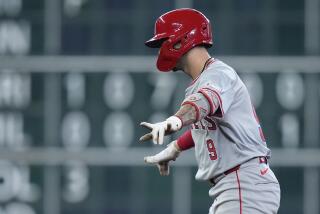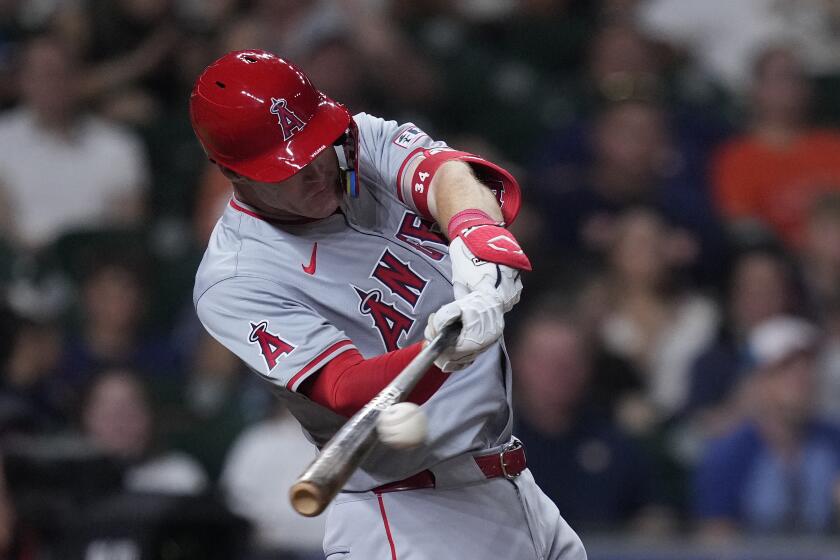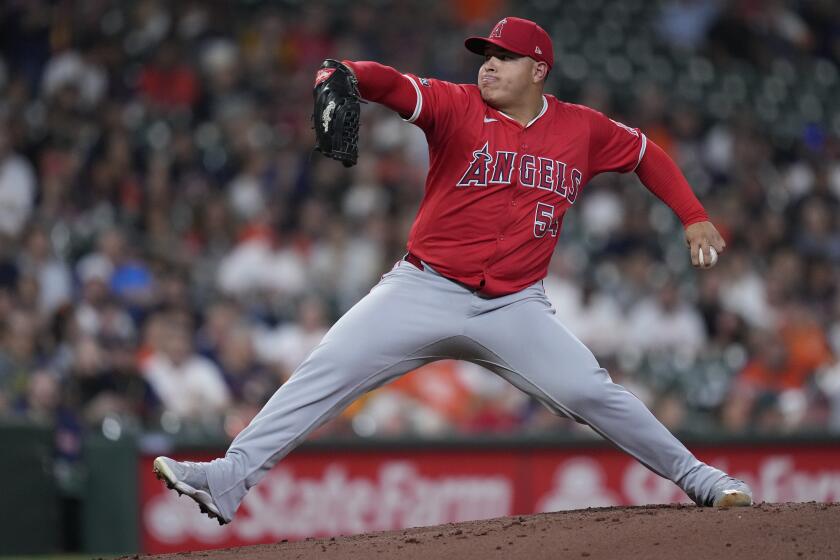This Year, Brett’s Most Impressive Stat Might Be Games Played
As the Anaheim Stadium audience busies itself between innings, a haunting, ominous number from the baseball movie “The Natural” is played, fitting since one stands in the Kansas City Royals’ on-deck circle awaiting his turn to injure a Kirk McCaskill pitch.
Mr. Living Legend soon steps to the plate. Two white Utica Blue Sox wristbands, gifts from his brother, the manager, decorate his arms. A white No. 5 dominates the back of his powder-blue jersey. The hitting crouch is courtesy of the late Charley Lau.
Three pitches later, George Brett’s 1,943rd career hit splashes gently in the right field grass. McCaskill can only admire the soft line drive.
In the fourth inning, this time behind in the count, 0-2, Brett again sends a McCaskill pitch to right field.
A pair of Hal McRae doubles score Brett each time.
Roy Hobbs would approve.
Brett isn’t through with his chores. Positioned at third base, he receives seven chances during the game and retrieves six. One of the ground balls skims the infield dirt at the last moment, making a routine play suddenly difficult. Brett gloves the ball with practiced nonchalance, examines American League President Bobby Brown’s signature and then snaps a throw to first baseman Steve Balboni.
None of this is particularly new to Brett. He always has been a competent defensive player. As for hitting, let his peers describe Brett’s ability to introduce bat to ball.
From Reggie Jackson: “I think George is the best left-handed hitter in the game.”
From Dick Howser, manager of the Royals: “I haven’t seen anybody that can hit like him.”
From newly acquired Angel pitcher Don Sutton, who has 293 careers wins on his resume: “When he’s hot, he’s the best hitter in our league.”
What makes Brett’s recent appearance against the Angels so noticeable is, well, his appearance. As summer edges into fall, Brett usually finds himself in a sling, cast, bandage or hospital bed. In Kansas City, the change of seasons isn’t signaled by the color of leaves, but by the sighting of Brett on crutches.
Before 1985, Brett’s body had survived just six of 11 seasons. Knee, hamstring, toe, wrist, heel, hand, ankle, finger and shoulder injuries account for the frequent visits to the league’s disabled list. You’ll be pleased to know that his elbows and possibly his neck are OK.
Translated into tangible terms, the Royals lose more often when Brett is absent. Last year, for instance, the Royals had .554 winning percentage with Brett in the starting lineup (101 games). Without Brett, the figure dropped to .459.
“He feels bad,” Howser says. “He knows he can’t help us win with him on the bench with injuries.”
Shortly before the beginning of the 1985 season, Brett approached Howser.
“He told me coming into spring training this year that his goal was to play in a 160 games,” Howser said.
Howser, a nice man not known to embarrass anyone on purpose, certainly not his meal ticket, nearly burst out in laughter. Excluding this season, Brett had averaged about 115 games during the last five years.
“He said 160,” Howser said. “I said, ‘George, I’d be satisfied with, say, 150. That would be plenty good enough.’ ”
Thus far, Brett has appeared in 132 games. There are no indications the remaining 24 games will be difficult to attend.
“I’ve missed six games all year,” says Brett, who is second in the American League with a .343 batting average and contends for honors in runs scored, total bases, slugging percentage, on-base percentage, walks, doubles, game-winning RBIs and extra-base hits. Brett also has 24 home runs, which won’t win any titles this season, but is noteworthy, nonetheless, since he hits for such a high batting average.
Two other numbers to remember: During the last 10 years, Brett is hitting .332 in late-inning pressure situations and in 1985, Brett has received 31 intentional walks, which is like the other team saying, ‘We give up.’ The American League record is 33, set by Ted Williams in 1957. The Major League record is 45, set by Willie McCovey in 1969.
“I really feel that 1979 and 1985 are probably the best years I’ve ever had,” Brett says.
But what about the 1980 season, the year Brett batted .390 and drove in 118 runs, a career best?
“In 1980, I missed too many ballgames,” he said.
Reasons for Brett’s health and resurgence (last year was the first time since 1974 that he hit below .300 vs. right-handers) are few and uncomplicated. Quite simply, Brett became less friendly with beers and more friendly with fruits and vegetables. His off-season work habits improved. He spent more of his day exercising than he did arranging tee-off times. It shows.
“I think the reason I’ve had a good year is because I’ve been able to stay in the lineup,” Brett said. “And if it’s because of the conditioning program I went on last year, it makes it all worthwhile. I missed too many games the last three, four years and thought it was about time that if I got in a little bit of shape I could probably play healthier and play in more games.”
Brett has watched with interest the efforts Pete Rose and his quest of Ty Cobb’s record of most career hits. With seven years remaining on his existing contract, Brett would pose little threat to Rose or Cobb. But say Brett’s health continues and he remains in the league for five more years. The what-ifs become interesting.
“If I could honor (the 7-year contract) I’d be very happy,” says Brett, who adds he’d consider an extended stay “if they wanted me and I thought I could still play. I’m not going to go out there and embarrass myself. I do that enough now when I’m young. I don’t want to do it when I’m 40 years old.”
Brett says he sets no long-range goals. Cobb and Rose are distant stars.
How about the past? Through his first 11 seasons, Rose had 2,152 hits. Brett had 1,778. With his totals this season, Brett could peck at the 2,000-hit mark. A decade later, who knows?
“I’ve thought about it a little bit, but the first thing that comes to mind is how long does he want to play?” Howser said. “Does he want to sacrifice in the wintertime instead of playing a lot of golf? Is he going to continue this conditioning thing?
“If he has the commitment to continue he can do it. My own feeling is that he can do it. I hope he does it. I hope he gets a chance, selfishly, because I could say I had a chance to be around him.”
None of this concerns Brett, who might call such conjecture statistical foolishness.
“Hopefully, I can make it through the year,” he says.
With that said, Brett returns to the batting cage. Earlier in the afternoon, before the regular batting practice session, Brett worked on his hitting stroke. Now he applies the finishing touches before spoiling McCaskill’s evening.
A ball sails over the right-center-field wall . . . another against the right-field wall . . . a line drive up the middle . . . another home run . . . another line drive.
More to Read
Go beyond the scoreboard
Get the latest on L.A.'s teams in the daily Sports Report newsletter.
You may occasionally receive promotional content from the Los Angeles Times.





